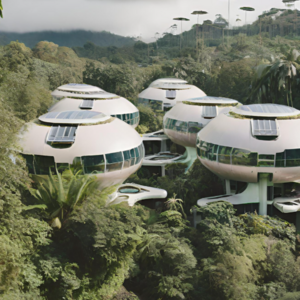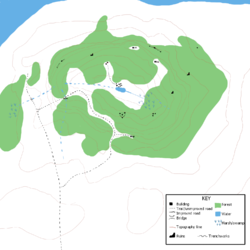|
|
| Line 28: |
Line 28: |
| ==Island Districts== | | ==Island Districts== |
| ===Housing & Entertainment=== | | ===Housing & Entertainment=== |
| | [[File:BlindshotHabUnits.PNG|thumb|The outside appearance of the Hab Units available to both stationed Arconans, their families, and civilians alike.]] |
| The lowlands that dominate the western and southern portions of the island are dedicated to the housing and basic needs of the troops, with facilities for anything from food to entertainment. Housing is separated into different sectors and provided for the soldiers’ families, should they have one. Rows of barracks form the eastern and northeastern edge of this district, providing them ample access to the training facilities nearby, and further separating the civilian family members and workers from the dangers thereof. | | The lowlands that dominate the western and southern portions of the island are dedicated to the housing and basic needs of the troops, with facilities for anything from food to entertainment. Housing is separated into different sectors and provided for the soldiers’ families, should they have one. Rows of barracks form the eastern and northeastern edge of this district, providing them ample access to the training facilities nearby, and further separating the civilian family members and workers from the dangers thereof. |
|
| |
|
Fort Blindshot is a multipurpose post dedicated to the planetary defense of Selen and the maintenance of the planetary garrison. Situated on an exctinct volcanic island in the north Ninasisa Ocean, the remote location is largely separated from any sort of large civilian population and offers easy defense from external forces through the use of turbolaser turrets and interconnected trench and bunker system built across the island. While the island’s population is purely imported (no native villages extant), it currently plays home to the headquarters of House Galeres.
History of Blindshot
Prior to the fort's construction, the island on which it is situated was sparsely and intermittently populated by various small communities of the native Selenian population throughout its more ancient history. Possibly due to the now-extinct volcano's activity at the time, the island lay derelict for much of its otherwise uneventful history. As a result, the island likewise has no historical name, save for its coordinates on maps of Selen.
Following the the destruction of many of Clan Arcona's military assets by the opening attacks of the Collective, the Twelfth Great Jedi War, as well as a brief counterattack by the Collective that ended in a resounding Arconan victory, the Clan was forced to reconsider its military situation at home as much as with its reorganized military. As Estle City was considered particularly vulnerable, and recognizing a need for an easily defensible staging ground, Arcona decided on the previously mentioned island to establish a large-scale base. Lacking a proper home at the time, House Galeres requested and was granted headquarters in the burgeoning military administrative sector of the fort. In honor of the recently presumed-deceased Miraluka, Consul Atyiru, the name "Blindshot" was proposed and approved for the base's designation.
Since then, Fort Blindshot has served on multiple occasions as Selen's quick reaction force, conducting peacekeeping operations as well as planetary security. Notable among these were the hunt for Collective stragglers from the attack on Selen; the post-plague bread-and-labor riots in Estle City; and the defense of civilians on Atolli island when archeological excavations unearthed a horde of ancient and hitherto dormant carnivorous creatures. Likewise, it has also been the consistent staging area for House Galere's reinvestment of Eldar, which was abandoned by Arcona and the DDF at the height of the plague.
Island Districts
Housing & Entertainment
 The outside appearance of the Hab Units available to both stationed Arconans, their families, and civilians alike.
The outside appearance of the Hab Units available to both stationed Arconans, their families, and civilians alike.
The lowlands that dominate the western and southern portions of the island are dedicated to the housing and basic needs of the troops, with facilities for anything from food to entertainment. Housing is separated into different sectors and provided for the soldiers’ families, should they have one. Rows of barracks form the eastern and northeastern edge of this district, providing them ample access to the training facilities nearby, and further separating the civilian family members and workers from the dangers thereof.
This sector of the island is also home to the base’s main starport, which is large enough to handle the logistics shipments needed to supply the base, as well as support the base’s fighters, transports, and assault ships. Indeed, it is not uncommon to see at least one of the DDF’s LAAT/i gunship platoons out on the tarmac, if not more, ready to train as they are to respond to a planetside emergency.
Outside of those partitions, and intermingled with the family housing subdivisions, are the commercial areas. Soldiers and their families still require entertainment, and that comes in the form of theaters, restaurants, bars, and other niceties that can be found in the mainland urban centers; albeit less numerous and with less variety. It provides shopping necessities and comforts, from tactical shops for the troops, to clothing and groceries for the rest. All this is powered by the base’s local powerplant, which supplements the trickle of power cabled in from Estle City across the ocean.
Training Areas & Ranges
The foothills that comprise the eastern third of the island, running along the coast from south to north, are dedicated to various firing ranges: anything from small arms to artillery and air-to-ground targetry. Starting nearest the habitation district in the south are the smaller items that most bases would not do without. A multitude of structures serve as classrooms and training facilities for the garrison, including tactical training simulators to mock cockpits for flight training.
Further up the strip of seaside land are the ranges. This includes a large obstacle course, full of ropes for swinging, crawling, and crossing; as well as a myriad of wooden barriers that must be surmounted; and no course would be complete without the mud pit with the ceiling of criss-crossing lines of barbed wire. From there are ranges that face out into the sea — generally used for gunnery for tanks and other big guns — and others that point toward the extinct volcano. These latter ranges use a series of energy-projection arrays to materialize targets for soldiers to engage with their rifles. After all, where blasters are involved, an energy barrier is cheaper to maintain than replacing transport-loads of flimpy targets.
Several ranges are large enough to facilitate a whole battalion’s movement through them for live-fire exercises, incorporating various types of droid and holo-targets in both open battlefields and mock villages or cities. While forestry is scattered throughout, the dominating features of this part of the island are the rolling hills that serve as much as a backstop to prevent shooting their fellow AAF troops as it does to create tactical complications for the large-formation leaders, who have to factor the terrain into their planning.
The Caldera
 A crude topographical map of the extinct volcano showing the locations of the various training and defensive structures scattered throughout
A crude topographical map of the extinct volcano showing the locations of the various training and defensive structures scattered throughout
The northwestern third of the island, the crater area of the long inactive volcano, is used to familiarize troops with a wide variety of terrain: from rugged uphill climbs, through forest, and down into the caldera valley where there are scattered streams, small marshes, and a small centralized lake. Rocky outcrops commingle with trees and soft earthen slopes to create a kaleidoscope of land, inhabited by equally varied, though small and generally harmless wildlife.
Throughout the wooded areas are derelict buildings and small fortifications to replicate some of the smallest and older habitations on Selen. Mock trenchworks and hidden bunkers are used as fake “enemy” habitations for training, while a few scattered “villages” slumber among the trees and flinty rocks. Down in the valley, among the open fields, lies a mock town, set up for troops to train in urban combat as well as, when roleplayers are available, conducting civilian support operations.
The town, butted up against the north side of the lake, is still relatively small, comprised of only a few dozen buildings of various sizes, and generally split down the middle by a central lane of broken pavement and packed earth. At the far western end of this road is the largest building of the village: a U-shaped structure three stories high, meant to represent a municipal administration structure. It is accordingly filled with offices, desks, and some of the better interior decorating compared to that of the other buildings.
Active defense positions are camouflaged and scattered around the area as well, filling in what would otherwise be blind spots in the defensive net. These laser and turbolaser turret positions are placed both inside and outside of the caldera, meshing the camouflage of the trees and vegetation with the naturally dominating height and angles of the terrain. Many are located close to the trenches used for training as a redundancy measure, as AAF troops would most assuredly occupy those same trenches to fend off a seaborne assault.